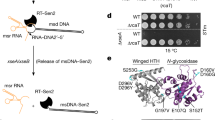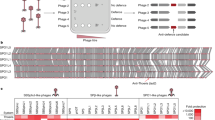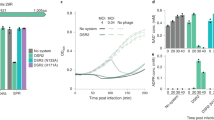Abstract
Toxin-antitoxin (TA) systems are broadly distributed, yet poorly conserved, genetic elements whose biological functions are unclear and controversial. Some TA systems may provide bacteria with immunity to infection by their ubiquitous viral predators, bacteriophages. To identify such TA systems, we searched bioinformatically for those frequently encoded near known phage defence genes in bacterial genomes. This search identified homologues of DarTG, a recently discovered family of TA systems whose biological functions and natural activating conditions were unclear. Representatives from two different subfamilies, DarTG1 and DarTG2, strongly protected E. coli MG1655 against different phages. We demonstrate that for each system, infection with either RB69 or T5 phage, respectively, triggers release of the DarT toxin, a DNA ADP-ribosyltransferase, that then modifies viral DNA and prevents replication, thereby blocking the production of mature virions. Further, we isolated phages that have evolved to overcome DarTG defence either through mutations to their DNA polymerase or to an anti-DarT factor, gp61.2, encoded by many T-even phages. Collectively, our results indicate that phage defence may be a common function for TA systems and reveal the mechanism by which DarTG systems inhibit phage infection.
This is a preview of subscription content, access via your institution
Access options
Access Nature and 54 other Nature Portfolio journals
Get Nature+, our best-value online-access subscription
$29.99 / 30 days
cancel any time
Subscribe to this journal
Receive 12 digital issues and online access to articles
$119.00 per year
only $9.92 per issue
Buy this article
- Purchase on Springer Link
- Instant access to full article PDF
Prices may be subject to local taxes which are calculated during checkout






Similar content being viewed by others
Data availability
The bioinformatic analysis was performed using protein sequences available in the Integrated Microbial Genomes (IMG) database (https://img.jgi.doe.gov/). DarTG1 and DarTG2 were identified in Escherichia coli C7 (NCBI accession GCA_001901425.1) and Escherichia coli 2-460-02_S4_C3 (NCBI accession GCA_000704545.1). Sequencing data are available on NCBI (BioProject PRJNA776027). Sequencing data were aligned to reference genomes of MG1655 (accession number CP025268.1), RB69 (accession number NC_004928), SECϕ18 (accession number LT960609) or T5 (accession number NC_005859.1). All other source data have been deposited to Mendeley Data V1 at https://doi.org/10.17632/v9bmr549nf.1. Source data are provided with this paper.
References
Bernheim, A. et al. Prokaryotic viperins produce diverse antiviral molecules. Nature 589, 120–124 (2021).
Cohen, D. et al. Cyclic GMP-AMP signalling protects bacteria against viral infection. Nature 574, 691–695 (2019).
Doron, S. et al. Systematic discovery of antiphage defense systems in the microbial pangenome. Science 359, eaar4120-18 (2018).
Gao, L. et al. Diverse enzymatic activities mediate antiviral immunity in prokaryotes. Science 369, 1077–1084 (2020).
Harms, A., Brodersen, D. E., Mitarai, N. & Gerdes, K. Toxins, targets, and triggers: an overview of toxin-antitoxin biology. Mol. Cell 70, 768–784 (2018).
Song, S. & Wood, T. K. A primary physiological role of toxin/antitoxin systems is phage inhibition. Front. Microbiol. 11, 1895 (2020).
Page, R. & Peti, W. Toxin-antitoxin systems in bacterial growth arrest and persistence. Nat. Chem. Biol. 12, 208–214 (2016).
Ronneau, S. & Helaine, S. Clarifying the link between toxin-antitoxin modules and bacterial persistence. J. Mol. Biol. 431, 3462–3471 (2019).
Yamaguchi, Y. & Inouye, M. Regulation of growth and death in Escherichia coli by toxin–antitoxin systems. Nat. Rev. Microbiol. 9, 779–790 (2011).
LeRoux, M., Culviner, P. H., Liu, Y. J., Littlehale, M. L. & Laub, M. T. Stress can induce transcription of toxin-antitoxin systems without activating toxin. Mol. Cell 79, 280–292.e8 (2020).
Christensen, S. K., Pedersen, K., Hansen, F. G. & Gerdes, K. Toxin–antitoxin loci as stress-response-elements: ChpAK/MazF and ChpBK cleave translated RNAs and are counteracted by tmRNA. J. Mol. Biol. 332, 809–819 (2003).
Fineran, P. C. et al. The phage abortive infection system, ToxIN, functions as a protein-RNA toxin-antitoxin pair. Proc. Natl Acad. Sci. USA 106, 894–899 (2009).
Guegler, C. K. & Laub, M. T. Shutoff of host transcription triggers a toxin-antitoxin system to cleave phage RNA and abort infection. Mol. Cell 81, 2361–2373 (2021).
Koga, M., Otsuka, Y., Lemire, S. & Yonesaki, T. Escherichia coli rnlA and rnlB compose a novel toxin-antitoxin system. Genetics 187, 123–130 (2011).
Makarova, K. S., Wolf, Y. I., Snir, S. & Koonin, E. V. Defense islands in bacterial and archaeal genomes and prediction of novel defense systems. J. Bacteriol. 193, 6039–6056 (2011).
Makarova, K. S., Wolf, Y. I. & Koonin, E. V. Comparative genomics of defense systems in archaea and bacteria. Nucleic Acids Res. 41, 4360–4377 (2013).
Jankevicius, G., Ariza, A., Ahel, M. & Ahel, I. The toxin-antitoxin system DarTG catalyzes reversible ADP-ribosylation of DNA. Mol. Cell 64, 1109–1116 (2016).
Lawarée, E. et al. DNA ADP-ribosylation stalls replication and is reversed by recf-mediated homologous recombination and nucleotide excision repair. Cell Rep. 30, 1373–1384.e4 (2020).
Schuller, M. et al. Molecular basis for DarT ADP-ribosylation of a DNA base. Nature 596, 597–602 (2021).
Zaveri, A. et al. Depletion of the DarG antitoxin in Mycobacterium tuberculosis triggers the DNA-damage response and leads to cell death. Mol. Microbiol. 114, 641–652 (2020).
De Souza, R. F. & Aravind, L. Identification of novel components of NAD-utilizing metabolic pathways and prediction of their biochemical functions. Mol. Biosyst. 8, 1661–1677 (2012).
Rack, J. G. M., Perina, D. & Ahel, I. Macrodomains: structure, function, evolution, and catalytic activities. Annu. Rev. Biochem. 85, 431–454 (2016).
Tromans-Coia, C. et al. TARG1 protects against toxic DNA ADP-ribosylation. Nucleic Acids Res. https://doi.org/10.1093/nar/gkab771 (2021).
Otsuka, Y. & Yonesaki, T. Dmd of bacteriophage T4 functions as an antitoxin against Escherichia coli LsoA and RnlA toxins. Mol. Microbiol. 83, 669–681 (2012).
McCorquodale, D. J. & Warner, H. R. in The Bacteriophages (ed. Calendar, R.) 439–475 (Springer, 1988); https://doi.org/10.1007/978-1-4684-5424-6_10
Ando, Y. et al. ELTA: enzymatic labeling of terminal ADP-ribose. Mol. Cell 73, 845–856.e5 (2019).
Srikant, S., Guegler, C. K. & Laub, M. T. The evolution of a counter-defense mechanism in a virus constrains its host range. Preprint at bioRxiv https://doi.org/10.1101/2022.04.14.488369 (2022).
Petrov, V. M., Ratnayaka, S., Nolan, J. M., Miller, E. S. & Karam, J. D. Genomes of the T4-related bacteriophages as windows on microbial genome evolution. Virol. J. 7, 292 (2010).
Warner, H. R., Drong, R. F. & Berget, S. M. Early events after infection of Escherichia coli by bacteriophage T5. Induction of a 5’-nucleotidase activity and excretion of free bases. J. Virol. 15, 273–280 (1975).
Pinilla-Redondo, R. et al. Discovery of multiple anti-CRISPRs highlights anti-defense gene clustering in mobile genetic elements. Nat. Commun. 11, 5652 (2020).
Bondy-Denomy, J. et al. Prophages mediate defense against phage infection through diverse mechanisms. ISME J. 10, 2854–2866 (2019).
Dedrick, R. M. et al. Prophage-mediated defence against viral attack and viral counter-defence. Nat. Microbiol. 2, 16251 (2017).
Rousset, F., Dowding, J., Bernheim, A., Rocha, E. P. C. & Bikard, D. Prophage-encoded hotspots of bacterial immune systems. Preprint at bioRxiv https://doi.org/10.1101/2021.01.21.427644 (2021).
Hallez, R. et al. New toxins homologous to ParE belonging to three-component toxin–antitoxin systems in Escherichia coli O157:H7. Mol. Microbiol. 76, 719–732 (2010).
Peltier, J. et al. Type I toxin-antitoxin systems contribute to the maintenance of mobile genetic elements in Clostridioides difficile. Commun. Biol. 3, 718 (2020).
Yao, J. et al. Type II toxin/antitoxin system ParESO /CopASO stabilizes prophage CP4So in Shewanella oneidensis. Environ. Microbiol. 20, 1224–1239 (2018).
Chen, I.-M. A. et al. IMG/M v.5.0: an integrated data management and comparative analysis system for microbial genomes and microbiomes. Nucleic Acids Res. 47, D666–D677 (2019).
Steinegger, M. & Söding, J. MMseqs2 enables sensitive protein sequence searching for the analysis of massive data sets. Nat. Biotechnol. 35, 1026–1028 (2017).
Bobonis, J. et al. Bacterial retrons encode tripartite toxin/antitoxin systems. Preprint at bioRxiv https://doi.org/10.1101/2020.06.22.160168 (2020).
Chung, C. T., Niemela, S. L. & Miller, R. H. One-step preparation of competent Escherichia coli: transformation and storage of bacterial cells in the same solution. Proc. Natl Acad. Sci. USA 86, 2172–2175 (1989).
Haldimann, A. & Wanner, B. L. Conditional-replication, integration, excision, and retrieval plasmid-host systems for gene structure-function studies of bacteria. J. Bacteriol. 183, 6384–6393 (2001).
Blomfield, I. C., Vaughn, V., Rest, R. F. & Eisenstein, B. I. Allelic exchange in Escherichia coli using the Bacillus subtilis sacB gene and a temperature-sensitive pSC101 replicon. Mol. Microbiol. 5, 1447–1457 (1991).
Datsenko, K. A. & Wanner, B. L. One-step inactivation of chromosomal genes in Escherichia coli K-12 using PCR products. Proc. Natl Acad. Sci. USA 97, 6640–6645 (2000).
Duong, M. M., Carmody, C. M., Ma, Q., Peters, J. E. & Nugen, S. R. Optimization of T4 phage engineering via CRISPR/Cas9. Sci. Rep. 10, 18229 (2020).
Jiang, W., Bikard, D., Cox, D., Zhang, F. & Marraffini, L. A. RNA-guided editing of bacterial genomes using CRISPR-Cas systems. Nat. Biotechnol. 31, 233–239 (2013).
Acknowledgements
M.L. was supported by a postdoctoral fellowship from the Charles A. King Trust Postdoctoral Research Fellowship Program, Bank of America, N.A., Co-Trustees. This work was funded by an NIH grant to M.T.L. (R01GM082899), who is also an Investigator of the Howard Hughes Medical Institute; the Sagol Weizmann-MIT Bridge Program (M.T.L. and R.S.); and grants to R.S.: the European Research Council (grant ERC-CoG 681203), the Ernest and Bonnie Beutler Research Program of Excellence in Genomic Medicine, and the German Research Council (DFG) priority program SPP 2330 (grant SO 1611/2). A.K.L.L. was supported by an NIH grant (R01GM104135).
Author information
Authors and Affiliations
Contributions
M.L. performed all experiments. S.S. helped with the construction of phage gene deletions and plaque assays, and with design and interpretation of phage evolution experiments. G.I.C.T. helped with strain construction, bacterial and phage growth and survival assays, and DNA extraction and sequencing. T.Z. helped with the cysteine and methionine incorporation assays. M.L.L. helped with bacterial and phage growth and survival experiments. M.B. and A.K.L.L. supplied biochemical reagents and controls and helped with design of ELTA assays. S.D. and R.S. performed a bioinformatic analysis of TA proximity to known defence elements. M.L. and M.T.L. designed experiments, analysed data, prepared figures and wrote the manuscript.
Corresponding author
Ethics declarations
Competing interests
R.S. is a scientific cofounder and advisor of BiomX and Ecophage.
Peer review
Peer review information
Nature Microbiology thanks the anonymous reviewers for their contribution to the peer review of this work.
Additional information
Publisher’s note Springer Nature remains neutral with regard to jurisdictional claims in published maps and institutional affiliations.
Extended data
Extended Data Fig. 1 Sequence alignment of DarT homologs.
Full multiple sequence alignments of representative DarT homologs corresponding to Fig. 1f.
Extended Data Fig. 2 Sequence alignment of DarG homologs.
Full multiple sequence alignments of representative DarG homologs corresponding to Fig. 1f.
Extended Data Fig. 3 DarTG systems provide phage defense via an abortive infection mechanism.
Growth curves for strains with the indicated plasmid-encoded TA system after infection with RB69 (a) or T5 (b) phage at varying multiplicities of infection (MOI). The mean and S.D. of 6-12 technical replicates are presented; data are an independent biological replicate for data presented in Fig. 2a, b.
Extended Data Fig. 4 DAPI-staining detects phage particles and changes in DNA compaction in infected cells.
a, Snapshots taken of cultures of E. coli MG1655 cells containing DAPI 10-20 min after addition of the indicated phage. b, Time-lapse series of DAPI-stained E. coli MG1655 cells on agarose pads containing 100 µg/mL carbenicillin (top) or untreated (bottom). Lysed cells are indicated with red arrows. c–d, Fluorescence intensity profiles of individual cells are plotted for DarTG1 (c) or DarT*G1 (d) cells. Profiles for 18-20 representative cells are shown for each condition and are grouped into diffuse (left), bimodal (middle), or asymmetric (right). Scale bars, 4 µM.
Extended Data Fig. 5 Less DNA is recovered from infected cells when a DarTG2 system is present.
Total DNA extracted from cells containing darTG2 or darT*G2 and infected with T5 for the times indicated. The intensity of the band at each time post-infection relative to the pre-infection band is reported at the bottom. Two independent replicates are shown.
Extended Data Fig. 6 Activated DarT inhibits the timing of phage protein production.
Protein synthesis rates as measured by 35S-labeled cysteine and methionine incorporation at various time points after infection for E. coli bearing the indicated plasmids and infected with either RB69 at MOI 5 (a) or treated with 300 µg/mL rifampicin (rif) (b). Data shown are representative of 2 independent biological replicates.
Extended Data Fig. 7 Gene 61.2 is not essential in T4.
Plaque assays of the wild-type T4, or variants with either a premature stop-codon in gp61.2 (L68*) or a large deletion of residues 65-196 (T4 61.2∆65–196) on E. coli with an active or inactive version of the DarTG1 system.
Supplementary information
Supplementary Information
Supplementary Tables 1–3.
Source data
Source Data Fig. 1
Statistical source data.
Source Data Fig. 2
Statistical source data.
Source Data Fig. 3
Statistical source data.
Source Data Fig. 3
Dot blot.
Source Data Fig. 4
Statistical source data.
Source Data Fig. 4
Autoradiograph image.
Source Data Fig. 5
Statistical source data.
Source Data Extended Data Fig. 3
Statistical source data.
Source Data Extended Data Fig. 4
Statistical source data.
Source Data Extended Data Fig. 6
Autoradiograph image.
Source Data Extended Data Fig. 5
Statistical source data.
Rights and permissions
About this article
Cite this article
LeRoux, M., Srikant, S., Teodoro, G.I.C. et al. The DarTG toxin-antitoxin system provides phage defence by ADP-ribosylating viral DNA. Nat Microbiol 7, 1028–1040 (2022). https://doi.org/10.1038/s41564-022-01153-5
Received:
Accepted:
Published:
Issue Date:
DOI: https://doi.org/10.1038/s41564-022-01153-5
This article is cited by
-
Anti-phage defence through inhibition of virion assembly
Nature Communications (2024)
-
Arbitrium communication controls phage lysogeny through non-lethal modulation of a host toxin–antitoxin defence system
Nature Microbiology (2024)
-
Structure-guided discovery of anti-CRISPR and anti-phage defense proteins
Nature Communications (2024)
-
Inhibitors of bacterial immune systems: discovery, mechanisms and applications
Nature Reviews Genetics (2024)
-
Molecular basis of threonine ADP-ribosylation of ubiquitin by bacterial ARTs
Nature Chemical Biology (2024)



